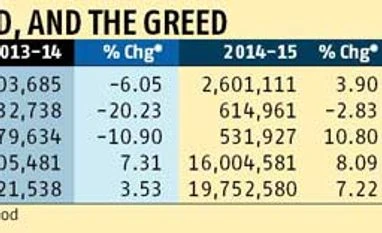On the back of a dozen new product launches, the passenger vehicle segment managed to post moderate growth in the last financial year, selling 2.6 million units. However, the figure was still lower than 2012-13 when the segment hit a peak sale of 2.68 million units.
Last year, with first-time buyers disappearing and existing car owners postponing plans for new vehicles, the passenger vehicle segment got saddled with excess inventory with discounts hitting all-time high. The sales growth of medium and heavy commercial vehicle (M&HCV) was the strongest last year at 16 per cent with only the scooter sales growth better than the rest. However, at 232,000 units the M&HCV sales figure pales in comparison with 2011-2012 when the segment peaked at 348,000 units.
One of the primary reasons behind the slow growth rate is the near-collapse in demand from the rural segment. Rural areas contribute up to 30 per cent of passenger vehicles and half of two-wheeler sales.
The first quarter of this year has brought little respite to the sector. While new launches have attracted buyers to showrooms pushing April-May sales by 10 per cent, early indicators of a slowdown in the urban market have become evident.
ALSO READ: Dip in auto sales growth: Blame softness in rural demand
Scooters, which are primarily sold in the urban pockets, marked a moderate growth of four per cent in April-May, against 25 per cent expansion recorded last year. Overall, domestic two-wheelers reported a fall of one per cent against last year’s eight per cent as rural demand took a knock.
Experts say the first two quarters of this year is expected to remain subdued as potential customers’ buying power will remain low. However, auto companies believe the first two quarters should not be held as an indicator for the year.
Last year, with first-time buyers disappearing and existing car owners postponing plans for new vehicles, the passenger vehicle segment got saddled with excess inventory with discounts hitting all-time high. The sales growth of medium and heavy commercial vehicle (M&HCV) was the strongest last year at 16 per cent with only the scooter sales growth better than the rest. However, at 232,000 units the M&HCV sales figure pales in comparison with 2011-2012 when the segment peaked at 348,000 units.
One of the primary reasons behind the slow growth rate is the near-collapse in demand from the rural segment. Rural areas contribute up to 30 per cent of passenger vehicles and half of two-wheeler sales.
The first quarter of this year has brought little respite to the sector. While new launches have attracted buyers to showrooms pushing April-May sales by 10 per cent, early indicators of a slowdown in the urban market have become evident.
ALSO READ: Dip in auto sales growth: Blame softness in rural demand
Scooters, which are primarily sold in the urban pockets, marked a moderate growth of four per cent in April-May, against 25 per cent expansion recorded last year. Overall, domestic two-wheelers reported a fall of one per cent against last year’s eight per cent as rural demand took a knock.
Experts say the first two quarters of this year is expected to remain subdued as potential customers’ buying power will remain low. However, auto companies believe the first two quarters should not be held as an indicator for the year.
ALSO READ: Bajaj Auto sales decline 22% in March
About a dozen launches and several upgrades in the car and utility vehicle space are set to hit the market this year. The luxury car segment will see 20 launches until December.
Market leader Maruti Suzuki, which has so far seen a 20 per cent growth in volumes in the first two months, appears the most optimistic. R C Bhargava, chairman, Maruti Suzuki, said: “Maruti expects double-digit growth this year. There is no serious worry about sales.”
Hyundai, Tata Motors, Mahindra and Mahindra, Honda, Renault and Volkswagen have also lined up all-new launches for the year, while others have promised product upgrades.
The pace of launches will be the same for two-wheelers and commercial vehicles. Honda, Hero, TVS Motors and Bajaj Auto have either already launched or are in the process of launching new products.
Much of that demand boost will be dependent on the monsoon, say industry experts. Pawan Goenka, executive director at Mahindra & Mahindra, said: “The current year’s monsoon will be the most important this year than earlier years. We expect the second half of the year to bring a change in rural demand.”
ALSO READ: Urban demand to drive auto sales in FY16
Tractor sales, heavily dependent on monsoon, saw its worst fall in many years. Monsoon deficit, lower crop production, low minimum support price, lower yield due to insufficient water coupled with financial constraint impacted sales since beginning of the second half of last year.
"The overall performance of the tractor industry has been subdued since the beginning of FY15. We believe that with recent positive development on monsoon situation coupled with governments’ higher thrust on agri sector would lead to strong bounce back in tractor industry in Q2FY16," said a report from Karvy.
ALSO READ: Auto makers look to FY16 for revival
)